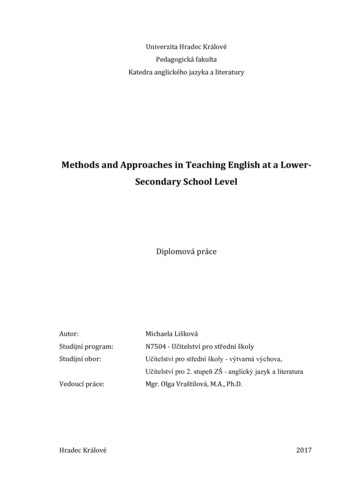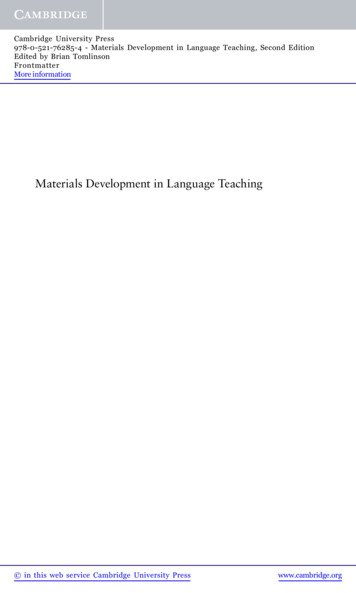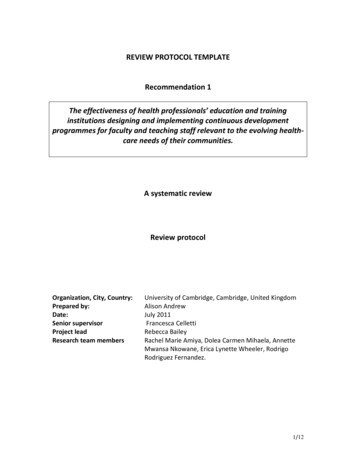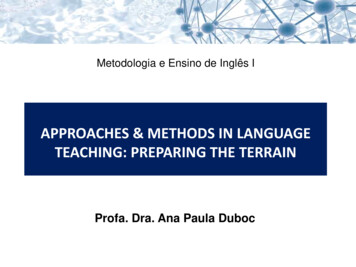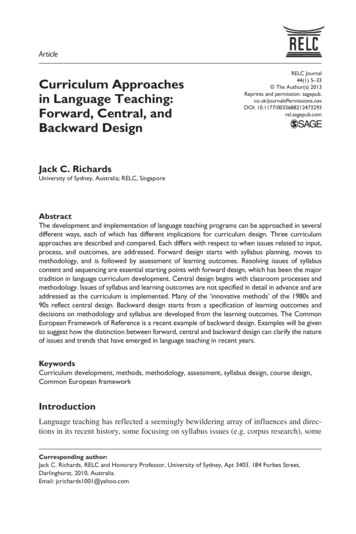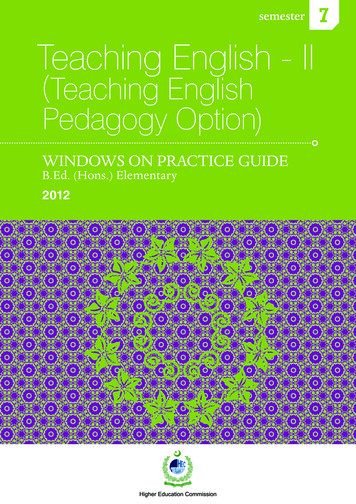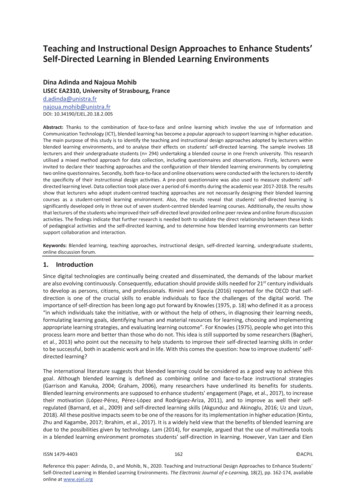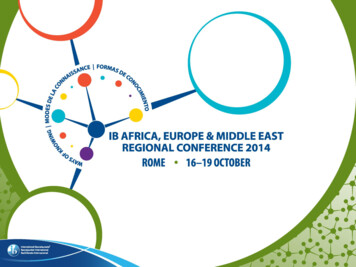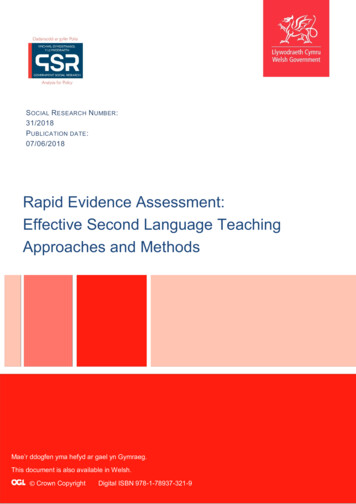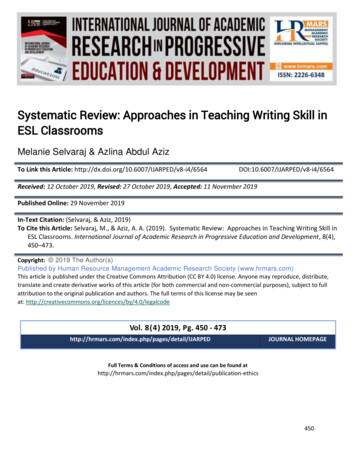
Transcription
International Journal of Academic Research in Progressive Education andDevelopmentVol. 8 , No. 4, 2019, E-ISSN: 2 2 2 6 -6348 2019 HRMARSSystematic Review: Approaches in Teaching Writing Skill inESL ClassroomsMelanie Selvaraj & Azlina Abdul AzizTo Link this Article: .6007/IJARPED/v8-i4/6564Received: 12 October 2019, Revised: 27 October 2019, Accepted: 11 November 2019Published Online: 29 November 2019In-Text Citation: (Selvaraj, & Aziz, 2019)To Cite this Article: Selvaraj, M., & Aziz, A. A. (2019). Systematic Review: Approaches in Teaching Writing Skill inESL Classrooms. International Journal of Academic Research in Progressive Education and Development, 8(4),450–473.Copyright: 2019 The Author(s)Published by Human Resource Management Academic Research Society (www.hrmars.com)This article is published under the Creative Commons Attribution (CC BY 4.0) license. Anyone may reproduce, distribute,translate and create derivative works of this article (for both commercial and non-commercial purposes), subject to fullattribution to the original publication and authors. The full terms of this license may be seenat: deVol. 8(4) 2019, Pg. 450 - DJOURNAL HOMEPAGEFull Terms & Conditions of access and use can be found tion-ethics450
International Journal of Academic Research in Progressive Education andDevelopmentVol. 8 , No. 4, 2019, E-ISSN: 2 2 2 6 -6348 2019 HRMARSSystematic Review: Approaches in TeachingWriting Skill in ESL ClassroomsMelanie Selvaraj & Azlina Abdul AzizFaculty of Education, Universiti Kebangsaan MalaysiaEmail: meljude5050@gmail.com, azlina1@ukm.edu.myAbstractThis paper presents an analysis of a systematic review based on the past studies published onwriting approaches employed in ESL classrooms. The studies reviewed are from the year 2000 to2019 with the total number of eighteen studies. The key aims of this systematic review is to showan empirical information formulation discovered through multiple methods in past scholarlyresearch on writing in ESL classrooms. In this systematic study, there are two study questions tobe addressed: i) What teaching methods should ESL students use to enhance writing abilities forlearners? ii) How should the defined writing strategy be scheduled so that it can be efficientlyapplied in the ESL schools? The findings of the reviews showed that process, genre, processgenre, process product and product-based approaches are employed in ESL classrooms. Processapproach was mostly employed in ESL teaching of writing in secondary and tertiary level. Resultsalso indicated that scaffolding cooperative learning and teacher and peer feedback help toimprove ESL students’ writing.Keywords: Writing Approaches, Writing, ESL Classrooms, Process Approach, Teaching WritingTheoriesIntroductionEnglish is a language widely spoken around the globe. About 1,121 billion people regardless ofnatives or non-natives speak English (World Population Review 2019). It is a language that bridgepeople in different sectors. English is language of business, education and communication, andeven seen as an official language and used in documenting. Second language learning differs fromfirst language acquisition. To meet these requirements there were various theories andhypotheses found and experimented to facilitate educators to impart the knowledge of secondlanguage. In addition, various researches di multiple disciplines, such as linguistics,psycholinguistics, psychology and education were carried out to enable students to learn secondlanguage. Listening, talking, reading and writing are the primary four language abilities taught tothese learners. “Writing is the most challenging skills to be learnt and to be taught in ESLclassroom” (Jusun and Md Yunus 2018, p.470). Writing skills is a vital skill that to be mastered byall the students in ESL classrooms as it has its various purposes. It goes beyond the school scope.451
International Journal of Academic Research in Progressive Education andDevelopmentVol. 8 , No. 4, 2019, E-ISSN: 2 2 2 6 -6348 2019 HRMARSThe Importance of WritingMastering writing skills is important due to its need in almost all the professions which needdocumentation, especially in this era. It is necessary to enter any modern workplace with goodwriting skills. According to Zhu (2004), business world requires and expect potential employerswith good writing skills and they are seen as the clients of corporate world. Therefore, it is vitalto equip oneself with good writing skills to get appointed and to disclosed to more jobopportunities. In other words, employee with good writing skills are seen as “hot commodities”Other than that, it is one of the most serious skill to the acquired in tertiary education. Academicwriting in tertiary is not just words but meaningful communication. Zhu (2004) added thatacademic writing includes understanding of distinctive procedures of ideas and interaction whichneeds basic or general writing abilities as a foundation. Besides that, writing promotes creativity,imagination, and understanding. Writing is a thinking process which involves brain process, inorder to organise ideas to write, writers need to imagine and be creative in putting their thoughtsin words. Therefore, it is compulsory to incorporate teaching of writing skills in primary schoolsas it is an important skill in communication in this globalised world (Hyland, 2015). Due to itsimportance, many countries have made English to be learnt in school as a second languageincluding Malaysia. In Malaysia, students learn English in all level of education starting frompreschool to varsity level. In second language learning, learners are identified as second languagelearners or ESL learners. There are various methods and strategies used to suit the ESL learnersto master the writing skills.Writing Issues among ESL WritersWriting is not easy as it “stimulates thinking, compels students to concentrate and organizedtheir ideas, and cultivates their ability to summarize, analyse, and criticize” (Maghsoudi andHaririan 2013, p.60). Bases on previous literature, the biggest challenge is lack of proficiency inEnglish language among ESL students in order to complete writing task assigned. Thus, studentsneed vocabulary, grammar, and ability to structure good sentences is a requirement to composea writing. Besides that, students feel lost and tough to compose in English since writing requiresto use many cognitive and linguistic approaches that students are unsure about. Generating andorganizing the ideas is seen as major problem for students who has some linguistic competencyin English. They struggle to produce a good writing pieces due to lack of knowledge in generatingand organizing ideas and to present their writing with good coherence. Another common issuein writing among ESL students is students are “lack of certain skill such as proper use of grammar,conventions, punctuation, capitalization, and spelling” (Ghabool et al. 2012, p.130; Ramasamy &Abdul Aziz, 2018, p.2266). Furthermore, according to Normazidah, Lie and Hazita (2012, p.41) “allESL students face more complicated problems, which may be either cultural or linguistic ones”.In line with this, students lose their interest in writing and gradually demotivates the students towrite. In contrary, some studies say lack of teachers’ pedagogical knowledge in writing and failureof choosing the right strategy to teach writing is another contributing factor for producingincompetent writers among ESL students (Md Yunus and Chan, 2016). These reasons maketeaching and learning writing daunting for ESL educators.Regardless of all the problems, writing skills in Malaysia is prioritised in the education systembesides the verbal communication skills. As formulated in Malaysian education Blueprint (2013452
International Journal of Academic Research in Progressive Education andDevelopmentVol. 8 , No. 4, 2019, E-ISSN: 2 2 2 6 -6348 2019 HRMARS2025), students need to be proficient in both Bahasa Malaysia and English covering all thelanguage aspects. Yet, after four years of implementing the blueprint, report shows, there is a“decrease in the percentage of passing for SPM English paper, from 79.4 per cent in 2016 to79.1 per cent in 2017” and for English Writing paper in UPSR examination, the percentage ofpassing dropped from 77.0 per cent in 2016 to 73.6 per cent in 2017” (Aziz, 2018 para. 15).Teachers, researches do employ many strategies to teaching writing skills to ESL learns, yet theresults are frustrating. One important area needed to be reviewed are the approaches employedby teachers in teaching writing. To see the efficacy of these approaches in developing studentswriting skills in ESL classrooms, an analysis of approaches used in ESL classrooms is required. Themain goal of this systematic review is to demonstrate a formulation of empirical data found viavarious approaches in previous academic studies on the teaching of writing in ESL classrooms.This is to create opportunity to researchers and teachers to formulate interventions and identifythe suitable approaches to cater the students’ needs and conduct researches in depth in thisarea.Literature ReviewTheories of Teaching WritingTeaching and learning writing in ESL classrooms are demanding. Researchers develop varioustheories to assist the learners and teachers because in ESL students have to cope with languageproficiency and the process of writing. Theories are crucial for the teachers to know andunderstand the theories in teaching writing because it will allow the teachers “to implementresearch-based practices better” (Wright et al. 2015, para 4). Hodges (2017) pointed out fourfocal theories in teaching writing.a) Cognitive Process theory of WritingWriting is a thinking process. To write, a writer needs to use the mental process such asbrainstorming, planning and organizing and it needs creativity. Therefore, cognitive wringprocess aims to teach students to use mental processing in producing a piece of writing.It is a popular than other writing theories as it has many benefits. This theory wasintroduced by Flower and Hayes (1981, p.366) “through observations of students’ writingand made effort to “introduce theory of cognitive processes involved in composing andto lay groundwork for more detailed study of thinking processes in writing”. The fourelements highlighted by Flower and Hayes in this theory are “Writers have to go througha process of thinking before writing, a higher-order organizational structure takes placeduring these procedures, composing involves setting objectives, and authors generatemacro and micro objectives to finish the writing task (Flower & Hayes 1981, p.366). Inshort it focuses exclusively on the mental writing process.b) Sociocultural theory of WritingSociocultural theory of writing was coined by Vygotsky which giving importance tomotivation, affect, and social influences as components of writing (Hodges 2017). In otherwords, it explains human learning as a social process and how human intelligenceoriginates in society or culture. Another key point in this theory is socialising or interaction453
International Journal of Academic Research in Progressive Education andDevelopmentVol. 8 , No. 4, 2019, E-ISSN: 2 2 2 6 -6348 2019 HRMARSis crucial in developing the mental action or process to acquire knowledge. Vygotskyintroduced Zone of Proximal Development (ZPD) which explains that students need helpand socializing to develop themselves (Vygotsky 1978). Therefore in a ESL writingclassrooms, students need collaboration with peers and scaffolding from the teachers aswell as peers.c) Social cognitive theory and self-efficacy in writingSocial cognitive theory in writing refers to how cognitive, behavioural, personal, andenvironmental factors interact to determine motivation and behaviour (Bandura 1993).This theory emphasizes in 3 main elements which are observational learning, imitationand modelling. On the other hand, self-efficacy refers to writer’s belief in accomplishinga writing task given and able to accept any challenges. This theory explains that, studentsalways developed their perception by looking at past production. Thus, they will choosea task where they have high self-efficacy and evade task with low efficacy. (Bandura2001). Four goal generalization keys pointed out are self-observation, self-evaluation,self-reaction and self-efficacy. Therefore, in a writing classroom students’ cognitive abilityand self-belief that is to meet challenges assists in writing instructionsd) Ecological TheoryEcological theory was proposed by Cooper (1986, p.368) described it as “an ecology ofwriting encompasses much more than the individual writer and her immediate context.The students in the writing class interact with one another to create systems that meansall the students or the product of writing both regulate and they are regulated by otherstudents’ writing in their own environment. One of the significant characteristics of thistheory is all the characteristics of any individual writer or piece of writing both determineand are determined by the characteristics of all the other writers and writings in thesystems. An important characteristic of ecological systems is that they are fundamentallyflexible. Although the structures and contents may be defined at a particular time, theyare continually evolving in actual time. The limitation of this theory is that it changesover longer periods of time.Definitions of Teaching ApproachesStudents in ESL classrooms come from various background and proficiency level due to manyfactors, one of it is exposure to target language. It may vary based on their location, urban orrural, family background or and in certain situations, students have mother tongue and firstlanguage before acquiring the third language. It is vital for ESL teachers to design a verysystematic and scrupulous plan for each lesson conducted to engage students then achievesuccessful learning. Hence, besides methods and techniques, approaches matched to their needsof the students is essential. “Approaches represents and interaction between the learner and thesituation of learning with strategies serving as negotiation link leading to as task outcome”(Lavelle and Zuercher 2001, p.375).Meanwhile (Richard and Rodgers 1986, p.204) defined“approach as a set of correlative assumptions dealing with the nature of language teaching and454
International Journal of Academic Research in Progressive Education andDevelopmentVol. 8 , No. 4, 2019, E-ISSN: 2 2 2 6 -6348 2019 HRMARSlearning which is the subject matter need to be taught”. In other words, it is a set of ideologies,principles or thoughts about the nature of learning which is decoded in the classroom setting.Definition of Writing ApproachesTeaching writing needs various approaches blended with strategies. Writing approach “describethe relationship between the beliefs that writers have about writing and the patterns of writingstrategies that they employ”. (Lavelle and Bushrow 2007, p.808). The concept of approachtherefore reflects an extensive view reflecting on the connection of beliefs regarding writing tomethods used by authors, which in turn affects the performance of writing results. In short,writing approaches are the ideas, rules and ethics related to writing process which applied in theclassrooms particularly in the teaching writing.Importance of Writing ApproachesWriting approaches are essential in every writing lesson. ESL teachers should determine theapproach need to be applied in one particular lesson for a few reasons. Identifying the correctapproach in a writing classroom is crucial to see an effective outcome. Choosing a non-idealapproach will simply make the lessons daunting to the ESL learners and cause disappointment tothe teachers after so much of handwork put in the planning and teaching. In other words, it willdemotivate the teachers as well as the students. Next, adapting an appropriate approach in theclassroom is important depending on the goal set by the teacher. For instance, beginners withvery limited proficiency should be exposed to product-based approach as they need model orexamples to begin their writing journey. Without an approach, the writing classroom will movein multiple directions thus the goal set for the particular lesson will not be achievable. Hence,writing approaches are important to meet the goals of the writing (Scott 1996). Furthermore,implying different types of approaches, enables students exposed to various types of methods.This will give opportunity to students to identify and use the correct approach in future writingbased on their writing purpose. Students who are aware of the approaches produce a qualitypiece of writing.Approaches to Teaching Writing in ESL ClassroomsWriting approaches to first language users differs from the second language learners. Researcheshad formulated many theories and approaches to cater to ESL learners writing needs. Thesewriting approaches has gone through a lot of changes over the years to enable the secondlanguage learners to become a good writer. (Fujida 2006). A few approaches identified bypractitioners for ESL learners they are such as product, process, genre approach and processgenre approach. (Md.Kamrul Hasan & Mohd Moniruzzaman 2014).Product based ApproachesProduct based approach denotes a writing process which aims to see the end product. Regularly,students imitate a model text to produce one. In other words, students mimic a modelcomposition provided by the teachers. For instance, in the writing classrooms, teachers provideexamples or model composition for the students and based on the models, students produce asimilar composition. Steel (2004) reported, in order to apply this approach in the ESL writing455
International Journal of Academic Research in Progressive Education andDevelopmentVol. 8 , No. 4, 2019, E-ISSN: 2 2 2 6 -6348 2019 HRMARSclassroom there are four steps to adhere;1) students need to read the model composition andtake note on the distinctive features of a composition which are organization of ideas, the use oflanguage and mechanics of writing. 2) students perform controlled practices to exercise theelements outlined in the model text.3) Students attempt to mimic the model essay by organizinga collection of pre-set thoughts to suit the model. 4) Students perform the task by using theirskills, sentence structures and various level of vocabulary in order to compose the anticipatedcomposition. Some of the advantages of this approach are students start learning how to useparticular pattern-product methods in writing composition systematically, especially in writingnarrative descriptive and persuasive essays. In addition, students learn to correct vocabulary andvarious sentence patterns for these text types and improve students’ grammatical awareness(Tangpermpoon 2008). Product based approach lost its popularity as it has no concern over theprocess of the writing but the grammar structure and syntax. It demotivates the students whenaccuracy in mimicking is focused rather than students’ creativityProcess based ApproachOn the other hand, process-based approach gives great importance to the process of getting theend product. There are four processes involved in the writing process; planning, drafting, revisingand editing. Kroll (2001, p.221) “explains drafting and receiving feedback on their drafts, be itfrom peers and/or from the teacher, followed by revision of their evolving texts is one of thecrucial steps in the process-based approach”. Adopting this approach enable writers to moveback and forth to improve their writing. It also promotes creativity when the writers create theirown composition. Thus, it is seen as a dynamic approach as recursive process takes place. Processapproach is popular due to its benefits. Students can enhance their writing abilities in theclassroom as scaffolding occurs. Other than that, feedback is given by teachers and peer, so itgives opportunity for students to become a better writer. According to Maarof et al. (2011, p.30)“teacher feedback is regarded as a main requirement for improvement in students’ essaywriting”. In addition, it stresses on thinking process, this will promote creativity. Despite all theadvantages, process-based approach has it disadvantages, it consumes a lot of time, focuses onthe process instead of structures and grammar.Genre based ApproachIn contrast, genre approach looks “writing as pre-dominantly linguistic but, emphasize thatwriting varies with the social context in which it is produced producing texts based on socialcontext” (Badger and White 2000, p.155). Genre based approach give importance to varioustypes of writing and text types and intertwined with social needs. It has some advantages as suchas students learns variety of sentence structures for different text types. “The objective of thisapproach is knowledge and certain genre and the communicative reason which will enablewriters communicate with the community” (Tangpermpoon 2008, p.6). There are someadvantages of this approach are it exposes students to different types of text types or genre.“Learners should be exposed to many examples of the same genre to develop their ability towrite a particular genre” (Elashri 2013, p.7). In addition, genre-based approach “concerned withteaching learners how to use language patterns to accomplish coherent, purposeful prosewriting” as every writing has its purposes to the readers (Tuan 2011, p.123). Other than that,456
International Journal of Academic Research in Progressive Education andDevelopmentVol. 8 , No. 4, 2019, E-ISSN: 2 2 2 6 -6348 2019 HRMARSgenre approach is suitable for beginners as model text is given to assist learning, this will reducethe anxiety among the learners. Above all, it scaffolds writing. Some limitations of this approachare students lack in knowledge of language structure and grammar to reach the target audienceand learners basically focus on the product rather than the process and it underestimates thestudent’s ability.Process Genre-based ApproachConsequently, process genre-based approach is a combination of all the three above, it focuseson the process of writing, taking account knowledge of social context and purposes of text ingenre writing and observes features of texts as in product-based approach. (Rhalmi 2018).Currently, process writing is given much emphasizes in ESL classrooms. It helps students toproduce and kinds of writing by employing the four steps. Besides employing these approaches,teachers also employ different types of strategies to make the teaching and learning writing insecond language classroom in fruitful. Some of the popular strategies “include modelling, sharedwriting, guided writing, and interactive writing”. (Lan et al. 2011, p.148). This approach has itsplus points, that is, it is more suitable to students in secondary schools. Its limitations are, it needscareful and tedious planning, it consumes a lot of time in planning and teaching.Process Product ApproachProcess product approach combines product approach and process approach. Employing thisapproach is to develop students writing skills by mastering product approach prior to processapproach. Students need to master writing mechanics and get familiar with sample texts ormodel essays at this stage and proceed with process writing, which is developing writingemploying all the stages in process writing stages namely, prewriting, drafting, revising, editingand publishing to compose a own generated story. This approach's main disadvantages are linkedto its complexity and the time and cost engaged in achieving it. (Carta 1987).Past StudiesThere are a number of studies that discuss the best approach for second language teachers toadopt, particularly in ESL classrooms. Nordin 2017 in his study on tertiary students reported thatthere is no one particular approach fits the ESL students in fact process and genre approachcomplements each other in teaching the writing skills.In another study, Watson (1982) has reported that, models or product-based approach is widelyopted in ESL classroom. Yet, he believes that, product-based approach alone does not helpstudents in writing but this product based approached should be integrated with process-basedapproach to produce a good writer.A study done by Hassan and Akhand (2010) in analyzing the impact on learners ' quality of theproduct and process approach to learning reported that the tertiary students performed betterin writing by combining product and process approach. The blending approach developed theirwriting skills.457
International Journal of Academic Research in Progressive Education andDevelopmentVol. 8 , No. 4, 2019, E-ISSN: 2 2 2 6 -6348 2019 HRMARSMost of the studies examines the two main popular approaches in teaching writing namelyproduct-based approach and process-based approach. However, there are other relevantapproaches such as genre-based approaches, combination genre process and product processapproaches which contributes to improve ESL students writing skills. Thus, only a little known inoutcomes of blended approaches in teaching writing.MethodologyThe method adopted conduct the systematic review is based on five steps proposed by Khan etal. (2003, p.118). According to them, the five steps are “framing questions for a review,identifying relevant studies, assessing the quality of studies, summarizing the evidence andinterpreting the findings”. The first stage of the procedure is framing research questions for thereview. Therefore, problems should be identified carefully and clear. The questions should bewell structured to avoid any ambiguity. A good research questions will lead to a good researchprocess. Once the questions are identified, other changes such as identifying the population andresearch designs are identifies. In this case, ESL learners in all levels, from primary to tertiaryeducation level are chosen. The next step is identifying relevant studies, where studies related tothe objectives set, we searched. I decided the use the online materials from well-knowndatabases, such as JSTOR, Google Scholar, Science Direct, Springer e-Journals and EducationalResources Information Centre or better known as ERIC, SAGE, Scientific Research Publishing andScopus were downloaded and read extensively prior to analyzing them. Boolean Operators wasused to connect and define the search terms relationship based on the objectives set. The thirdstep is assessing the quality of the studies where a step by step review was done. I have recheckedthe research questions and the objectives are relevant to each other and to the journals and thearticles chosen. The fourth step is summarizing the evidence collected and tabulated usingstatistical method to interpret the data and supported with graphics for better comprehensionuse. Finally, the study was summarized with recommendations.458
International Journal of Academic Research in Progressive Education andDevelopmentVol. 8 , No. 4, 2019, E-ISSN: 2 2 2 6 -6348 2019 HRMARSFindings and DiscussionTotal of 15 studies based on the writing approaches from the year 2000 to 2019 were chosen forthe systematic review and the findings asStudyNo highschoolQualitativeCase study2Karimah,Setyona &Sukmaantara(2017)8th d)120students3Gutiérrez,Puello &Galvis(2015)20participants fromActionresearchexperimentalTypes tion1monthBlendedlearningusingEdmodo inwritingGenrethe learnersshoweddifferentreactionsbased onthe UsesandGratification Theory(UGT)frameworkto the useof Edmodo.Usingpicturesseries toenhanceGenre3meetings of 80minutesProcessbasedapproach,produc16weeksResults Genrebasedapproachedcan betaughtusingEdmodo Edmodofacilitatesthestudents’engagement in theteachingcognitivelythroughNote menu. BlendedlearningusingEdmodo inwriting,studentsshowedindependence in writinga personalrecount text Theexperimental groupwhich459
International Journal of Academic Research in Progressive Education andDevelopmentVol. 8 , No. 4, 2019, E-ISSN: 2 2 2 6 -6348 2019 cessbasedapproach4Jones(2006)18 college QualitativestudentsCase study5 males 13femaleUse ofWeblogs asapedagogicaltool for thewritingprocessApproach5Wei(2016)19studentsfrom thefirst torycase studyuse ofGenregenreapproacbasedhwritinginstructionto acquirethe genreconventionsof writing amini &Md Yunus(2019)55SecondaryFourpupilsactionresearch Use hi-fiveFingers andSnack Barsin etter Blogginghas beenshown to bean efficientwritinginstrument Processbasedapproachfacilitatedandstudentswere awarefor writing; studentsmotivatedto writing improvedtheir abilitytodemonstrate all therhetoricalandlinguisticconventionsof a literarycriticism. there is animprovement inpupils’grades intheirwritingperformanc460
International Journal of Academic Research in Progressive Education andDevelopmentVol. 8 , No. 4, 2019, E-ISSN: 2 2 2 6 -6348 2019 HRMARS(Powtoon &Facebook).7Barrot(2016)171 nce oftheFacebook eportfolio onwritingmethods ExperimentalResearchOne group(pre posttest)Experimentresearchdesign(Controlgroup andexp
Keywords: Writing Approaches, Writing, ESL Classrooms, Process Approach, Teaching Writing Theories Introduction English is a language widely spoken around the globe. About 1,121 billion people regardless of natives or non-natives speak English (World Population Review 2019). It is a l
